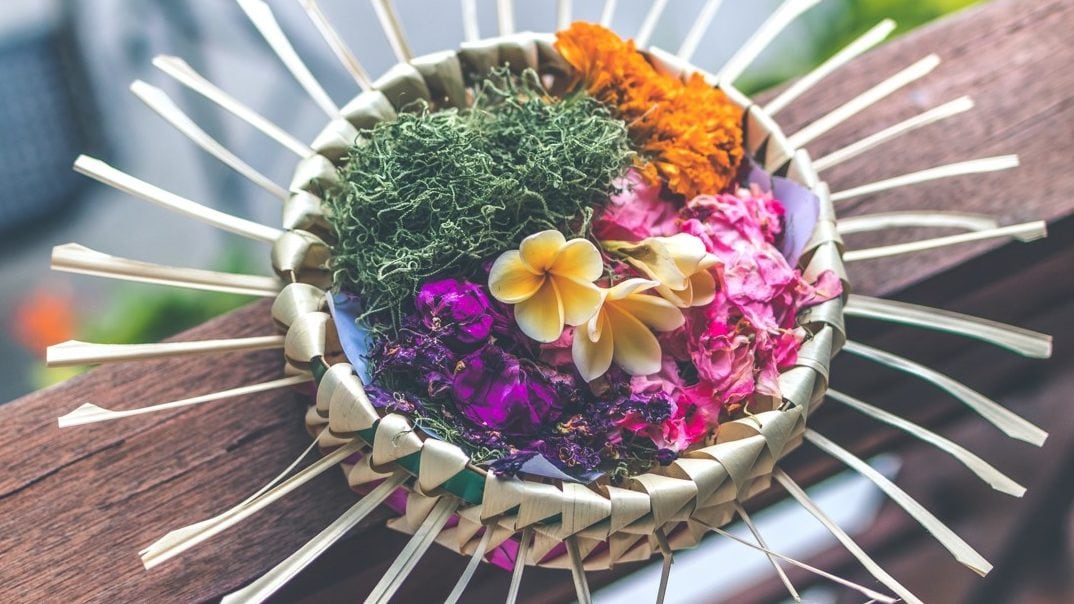By Gaia Grant
An examination of the ways in which beliefs and values are passed on to children informally through rituals and ceremonies in the home and the community and any opposition that might be experienced.
Support from every facet of the community
While the fundamentals of the Hindu faith in Bali are covered thoroughly at school, the practical and integrated nature of the faith is cemented in the home. It is only because there is strong and unwavering support for the religion from both the school and the family that Balinese Hinduism is as comprehensive and influential in society as a whole in the way that it is.
Because what is learnt at school is discussed and practiced at home, and vice versa, there is an ongoing feedback system that builds a strong scaffolding to allow for growth. In fact, it is probably because both of these sources of information and inspiration are as strong as each other that the faith is an integral part of Balinese daily life, as expressed through each individual.
Furthermore, there are opportunities for extended involvement in religious practices and expressions through local community based and government organisations. Local Sanggar, for example, are privately organised cultural centres based in the local community that offer classes in a range of religious arts (Ketut Sastrana, Blahbatuh Sanggar, 1999). The Hindu Foundation also offers classes in different areas of faith, and after that there are Hindu universities where one can seriously study the religion (The Hindu Foundation).
This means that a child might, for example, choose to study Balinese dancing as an extra-curricular activity at school, practice dancing while at home, study dancing more formally through a local Sanggar, and ultimately be involved in a dance for a local temple festival. Many young girls would start learning dancing at age five, and would become accomplished performing dancers only a few years later.
Other religious arts that might similarly be covered in the same range of contexts are learning an instrument from the gamelan orchestra, and singing. A boy might start learning a gamelan instrument from the age of ten years, and boys and girls would start singing lessons a year or two before that. Mask making is a sacred art that is more likely to be handed down from generation to generation through families than taught formally. Other religious positions and duties, however, are thought to be spiritually ordained, and do not have the same rigorous training opportunities.
Participation in daily rituals
The emphasis on ritual in the faith must also help to cement the religion into the hearts and minds of the Balinese (Purwita, 1993). Because the faith is not really open to personal interpretation and varied practices, but is rather tied down to very specific requirements, and because these are repeated on an extremely regular basis, faith quite easily becomes a habit, which then naturally becomes an integrated part of one’s daily life.
Everyone regularly practices Sembayang, or prayers. Three times a day – at 6am, 12midday, and 6pm – someone in a family will usually prepare small offerings to place in the family shrines. Offerings are an essential part of the Hindu faith. In the Mahabharata, Krishna tells Arjuna that God proclaims, “Whosoever offers to me with devotion a leaf, a flower, a fruit, or water, that offering of love, of the pure heart I accept.” (Mahabharata, ix: 26)
A good Hindu home (and a wealthier one) will have golden painted shrine platforms placed up high in the corner of every room. There is also usually a household temple in each family compound. The canang offerings placed in these places will consist of a small tray made from coconut leaves woven and folded to become a box shape, filled with special leaves and flowers and some dupa incense. As well as being offered as a gift to the gods who reside in those shrines and protect each of those rooms, smaller less elaborate offerings are also made to the demons to appease them. These are usually placed on the ground – at the front door or front gateway to the house and on pathways and roads. Sometimes something more valuable is placed in the shrine and temple offerings, such as money or jewellery, as a real sacrificial offering.
Small offerings are also usually prepared after meals are cooked and before the food is eaten. Small portions of rice and the other foods cooked are placed inside a leaf and then put on top of the cooking pots and at other strategic places.
Children will be able to observe and start to participate in this practice from a young age. They will start to help make the offerings, or certainly, at the very least, watch as the women pass lengthy periods of time making them. Banten tegeh are also made by women to carry to temple ceremonies. These are tall mountains of fruit and brightly coloured cakes stuck into skewers which then go into a central banana stalk stem.
Large bamboo decorations made for religious ceremonies, known as banjen or penjor, are usually made with by the men, and boys will start to help out with making these from about the age of ten years. The men in a village are also responsible for preparing and cooking the food for ceremonial feasts, chopping finely meat, vegetables and spices for the special minced lawardish, or preparing suckling pig, for example. Older teenage boys would start to help with these tasks by about fifteen years of age.
Prayers are also offered at school and in the temple, so there are plenty of opportunities for the child to learn and practice these rituals. The prayer itself, the Trisandya, is formally learnt in classes (Penuntun Belajar Agama Hindu Kurikulum, 1996). When a child first starts in kindergarten or Teka at five years of age, he or she will be required to learn and recite the first verse of the Trisandya. By the time the child is seven years old, he or she will already know all six verses.
Passing through rites of passage
There are a number of rites of passage through which each individual must pass in order to be purified and prepared for their spiritual journey through life (Eiseman, 1990). These are usually related to specific stages of physical development, and start soon after conception, so everyone is intimately involved in these rites and soon becomes familiar with the associated practices.
These particular rites of passage, known as the human rites or manusa yadnya, are a distinct category of rites – just one of many kinds of rites that the Balinese practice. There are four separate features of each of these ceremonies, each of which is religiously performed as part of the overall process of sanctification.
The mabiakala, firstly, is a sacrifice to the evil spirits to ensure the ceremony is not disturbed during the ceremony. The majayajaya(literally, prosperity), secondly, is a blessing and form of purification, which often simply involves a sprinkling of holy water, but this part of the ceremony can also be a lot more complex and involved. The third aspect, known as natabor ngayab, involves wafting the essence of a deity either toward or away from oneself. The gods of the nine directions are invited to enter the person’s body, who will then each dwell in a different part of the body. The fourth essential element of these ceremonies is muspaprayers.
There are 13 human rites of passage that are recognised by Balinese Hindus. These include:
- Six months after conception Pegedong-gedongan
- At birth Untuk kada empat
- When the umbilical cord falls off Kepus pungsed
- Twelve days after birth Ngelepas hawon
- 42 days after birth Tutuang kambuhan
- 105 days after birth Telubulan
- 210 days after birth Oton
- When adult teeth appear Ngempugin
- When last milk tooth falls out Maketus
- At puberty Munggah daa/teruna
- Before marriage (tooth filing) Mapandes
- Marriage Pawiwahan
- For study Pawintenan
These ceremonies may be celebrated to a greater or lesser degree depending on the individual family or community emphasis and wealth. However simple or elaborate the ceremony, these occasions are always happy times for the family and community. Sometimes the ritual will be just a short formal procedure restricted to immediate family, but often everyone associated with the individual involved participates in the detailed preparations. The whole community, in these cases, helps with the elaborate offerings, with the time-consuming and tiring food preparation, and with the extensive decorations.
Not in the same category of ritual – but nevertheless an important ceremony in the human life cycle – are the ceremonies connected with death and cremation. Ceremonies related to death are in a category of their own, and are known as the pitri yadnya. Cremation ceremonies are usually grand affairs, as it is important to go to as much time and expense as possible to ensure the spirit of the person who has died is shown due respect – particularly since that person will soon become a deified ancestor with great power.
Apart from the temporary preservation of the body until a day that is auspicious according to the Balinese calendar is chosen for the actual cremation, preparations for the event itself will include a whole series of different tasks. Some men in the community will be busy preparing the materials for and building the necessary temporary structures from bamboo poles and coconut leaves for days on end, while women work full-time for weeks before making all the offerings required. At least one life sized animal-shaped sarcophagus will be made, as well as the huge cremation tower. Apart from all this, a place for the formal ceremony is prepared – with chairs and lights in a marquee, and a priest is called to officiate. After the event, there is a further series of ceremonies, and everyone must be given gifts and thanked for their help, so the whole process can take weeks or even months.
The sheer number of these rituals, the amount of work involved in each one, and the dense social context of Balinese society means that the average Balinese child will be exposed to and involved in religious events on an extremely regular basis. Add to this the cyclic religious observances, such as the recognition of the new and full moon phases, special observances for various gods, and special events on the Balinese calendar, when the ancestors are called down to earth, and there is an almost constant string of religious events for the child to be absorbed into.
The special events on the Balinese calendar are Galungan, Nyepi and Kuningan(Suriana, SMU Taman Sastra Jimbaran, 1999). Other cyclic rituals include those that take place every six months (keeping in mind the Balinese calendar has 35 days in each month) include ceremonies for particular gods, including the Sabuh Mas for Dewa Mahadewa, the Soma Rinek and the Pagerwesi. There may be several ceremonies for the one god, also. The Anggara Kliwon, Buda Wage, Bude Kliwon and Saniscara Kliwon, for example, are all for Dewa and are held every month. More often than that is the Kajeng Kliwon, which is for the manifestation of the god Siwa, and is held every 15 days.
A socially dense community
The physical structure of the Balinese villages and relational structure of family and village life are important factors in the children’s exposure to religious events and the acculturation of the children into the religion. Communities are very close in terms of proximity as well as in terms of regular contact and mutual support.
The average Balinese village is designed first and foremost to fit in with the religious requirements of buildings (Couteau, 1999). They must be oriented in the kaja-kelod direction – that is, facing towards the mountains and away from the sea – with the most sacred of buildings, such as the temples, in the kaja position, and the most profane, such as the garbage area and the cemetery, in the kelod position. After that, they are designed around the community family compounds, which are in themselves a microcosm of the village set-up.
Each family compound consists of a central courtyard that is usually lined by sleeping rooms, a cooking room, bathroom etc. The direct descendents of the eldest male will live in this area, as well as the wives of any of his sons, so there may be quite a few generations and individuals living in the one area together. Regular chores such as cooking, cleaning, chopping wood etc are shared by the extended family – as are, of course, all religious preparations as well. It is not unusual to see extended family groups sitting around in an open bale and chatting as they prepare decorations or offerings together. The compounds that adjoin each separate family compound are usually housed by further members of the extended family, and would often include the brothers, sisters and cousins of the head male.
With the nuclear family structure of countries such as Australia, privacy is valued and respected and there is usually limited time spent with extended family members and even, often, with members of one’s own nuclear family. Each individual will sleep in a separate bedroom and can spend extensive periods of time in his or her own room – or in one of the many other rooms in the house – behind closed doors, if desired. Each person will often be engaged in personal pursuits, such as reading, computer activities, listening to music, watching TV, and so on. Privacy from neighbours is protected by walls and fences, and there is not always a close proximity to extended family members.
Western education systems, too, tend to encourage individual thought and expression, and this spills over into the ways religion is learnt and expressed. Individualism is valued to the extent that is possible to learn about and express religion completely independently of anyone else.
These factors may well contribute to the current difficulties many adults have with encouraging their own children to follow their own faith.
For the Balinese, religious values can only be expressed in the context of community. In socially extended close living communities such as the Balinese community, children spend a lot of time with extended family and friends and learn to imitate and adapt to religious practices even as they learn to speak and walk. Religion is not an independent choice or a private affair; it is a community practice and unspoken expectation. Learning about faith, too, happens naturally and obviously in the community context. Although the fundamentals of faith are covered in theory and, to some extent, in practice in the schools, it comes alive in the community. Faith becomes a holistic expression of the society and its values rather than an individual expression of private thoughts and beliefs.
The principle that is paramount in the way Balinese society operates and which highlights the importance of community involvement in all aspects of life is expressed in the gotong royong (Eiseman, 1990). In practice, gotong royong often refers to the working groups – in Australian society often called “working bees” – which combine together to fulfil community obligations for ceremony preparations, general community maintenance, and so on.
Respecting and learning from elders
The inherent importance of having a respect for elders must also be a major contributing factor to socialisation into the faith. The whole of society has a hierarchical structure according to the Hindu belief. The caste system works on the belief that through reincarnation, and through repeatedly following kharma rather than adharma, people can acquire higher status, until they eventually reach the pure state of Nirwana(Supartha, 1995). There are the higher, or more privileged castes of the Brahmanaand then the Ksatriya, and then the lower castes of Wesyaand Sudrarespectively.
Respect is automatically given to those of a higher caste, and this difference in status is most easily discerned in the levels of language. There is, for example, a completely different language to be used when talking to those of the Brahmanaor priestly clan than there is if you are talking to a “commoner” of a lower caste. Children learn the concept of respect early, therefore, as the most powerful absorption of concepts can be through the use of language. Age, similarly, is respected, and different words are always used when referring to or talking to someone older than you.
This means that when it comes to religion, children will have grown up to respect priests and religious teachers as well as the elders in their own family, including parents, grandparents, aunts and uncles, and so on. Because true respect often translates into trust and content obedience, religious values are listened to and accepted without question. Also rather than encouraging discussion and open negotiation, when parents deal with children they will expect their requests to be followed without questioning.
It is interesting to discover that it is very rare that children choose not to want to go with their parents to temple ceremonies or to assist when performing religious functions (Suriana, 1999). The Balinese would not usually attempt to coerce a child if any reticence is expressed, unusual as it is, but where there is any opposition to religious observance the children usually eventually choose to participate of their own accord.
Ironically, too, the Indonesian government has encouraged people to follow what has been handed down to them without questioning, so this has carried over into the acceptance of religion. The education system has, for many years, had an emphasis on rote learning and the retention of facts, so many children must similarly accept the faith that has been handed to them without challenging its premises, as is more common in societies where critical analysis and independent thought are encouraged.
The future of the faith
The recent major turn of events over the last few years – climaxing with the first truly free and democratic election in Indonesia – has already introduced the first steps of freedom of expression. It will be interesting to see how this filters through to areas such as religious beliefs and expression.
Bali may still be fairly immune to the effects of open thought and the possible watering down of their religion, however, because the Balinese value their own culture so strongly that they often consider themselves to be more Balinese than Indonesian. Pride in their own religious and cultural heritage, therefore, may make them want to stick firmly to their beliefs and traditions.
For the end of the end of the 20th century and the beginning of the new millennium, adherence to Balinese Hinduism by the majority of the Balinese population does not look as though it is waning in the slightest. Though the religion has ancient roots, it is in no way an outdated remnant from the past that has no place in the 21st century. As Adrien Vickers said almost ten years ago:
“Bali can be said to be genuinely modern, because it is part of an international tourist industry while having religious and artistic traditions which are internationally respected. Balinese own motorbikes and fax machines, while at the same time going to trance seances or obtaining holy water from brahman high priests. There is no contradiction in these things, since the traditional and the modern in Bali are two aspects of a complex social system.” (Vickers, 1990:213)
The next few years of political and economic resettling after a period of significant upheaval will no doubt alter the context and direction of the faith.
Unless there is a dramatic change to the way Hinduism is perceived and practiced in Bali, however, it appears that the religion will continue to be successfully passed on from generation to generation. Through the significant efforts of the educators and elders of the community, who teach the faith both formally and informally in the school context and through family and community activities, most young Balinese are growing up to accept and practice Hinduism “religiously”.
Sources:
©2000 Gaia Grant
T-Thoughts articles may be reproduced with written permission and must also be acknowledged with a web link back to the Tirian pages.

Gaia Grant (PhD) is a lecturer and researcher at the University of Sydney Business School in the Discipline of Strategy, Innovation, and Entrepreneurship, focusing on research into innovation paradoxes and ambidextrous leadership. Gaia is also a Director of Tirian Innovative Solutions, & the co-author (with Andrew Grant) of a number of books including ‘The Innovation Race’, and “Who Killed Creativity?”.

Andrew Grant is the Director of Tirian Innovative Solutions, and co-author (with Dr Gaia Grant) of a number of books including ‘The Innovation Race’, and “Who Killed Creativity?”.


